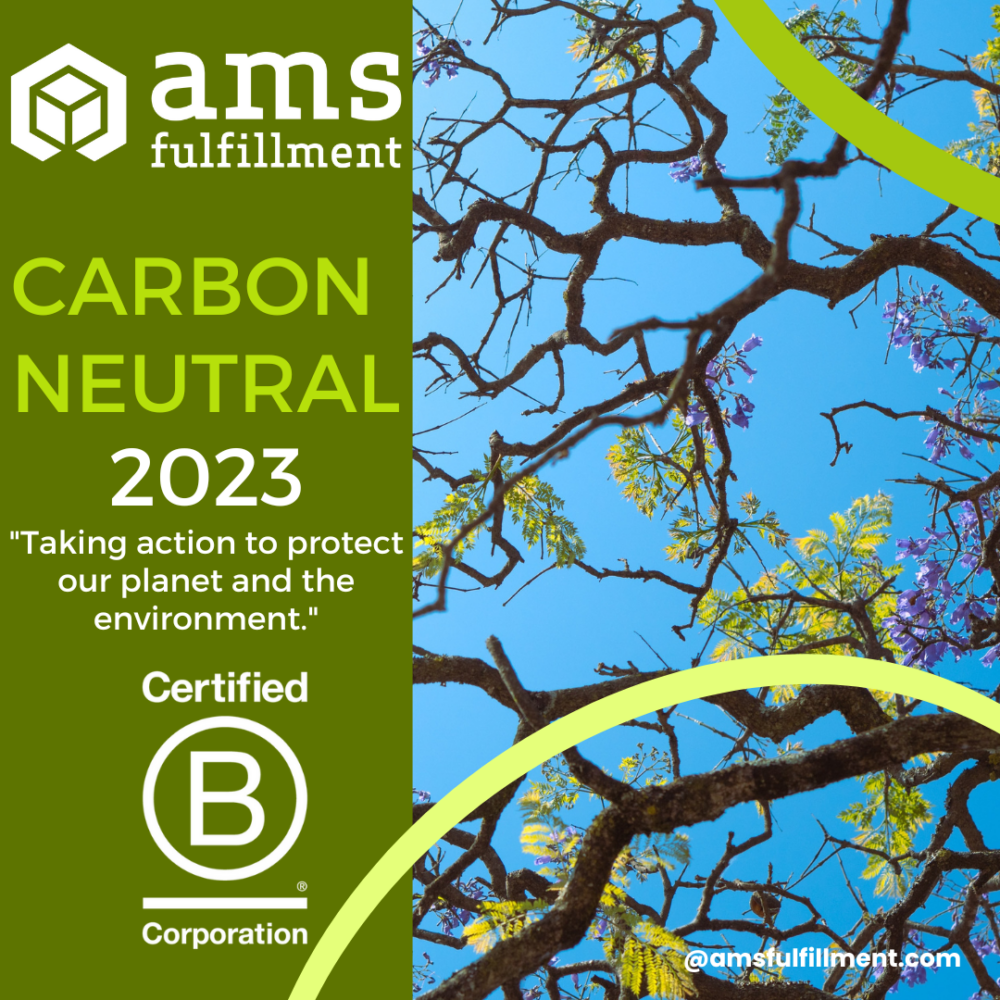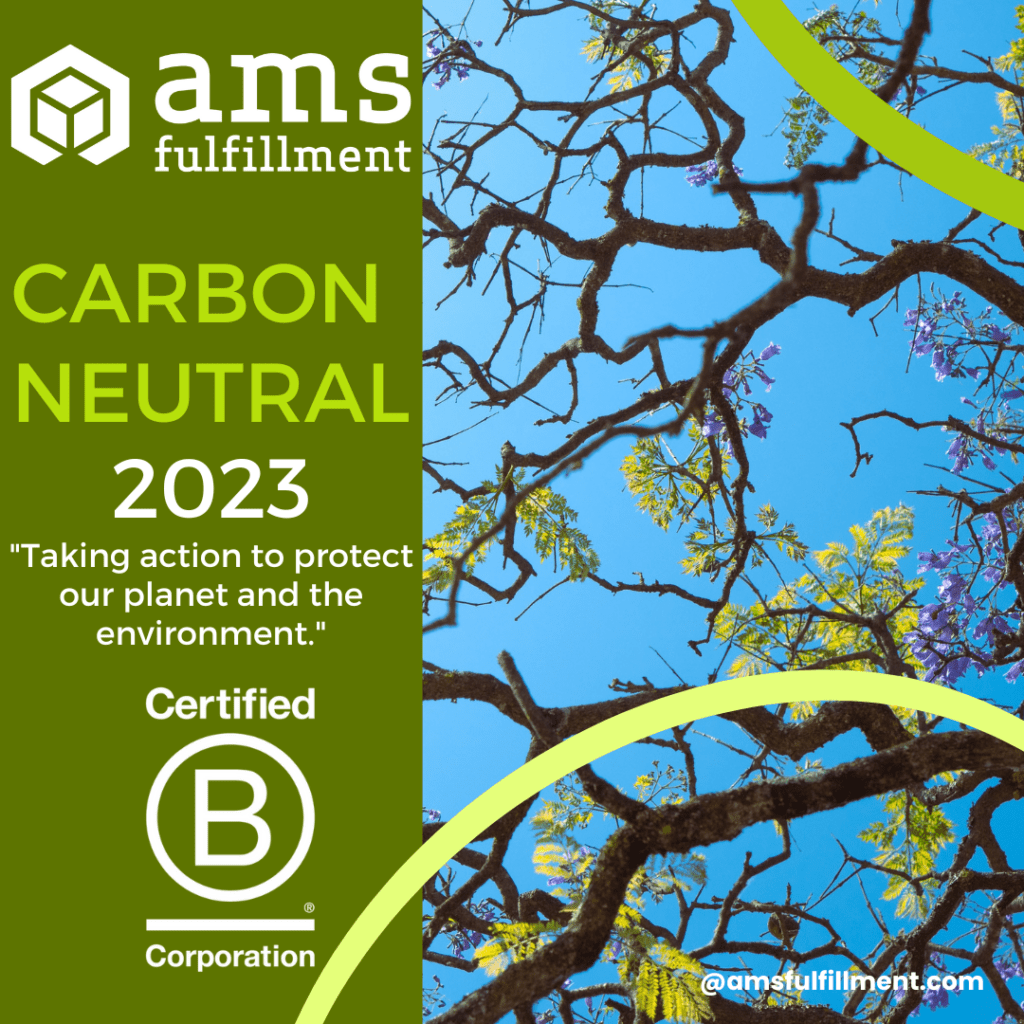

We know that some time ago AMS worked on the lighting in the warehouses, making them more energy efficient. And we know that gas powered equipment has been replaced by electrically powered equipment. We are proud to mention in our blogs that AMS uses, and influences our clients to use, earth friendly packaging. We recycle cardboard and metal, and we monitor lighting and energy use. We have implemented an employee waste disposal program and we have established a Vanpool for our California employees. And, it took some effort, but we found a way to bale and recycle plastic stretch film so that it can be re-made into products and re-used.
We know AMS has brought in some advisors to help us visualize how to make ourselves even greener. Our company has achieved Carbon Neutral status in 2023 and that must have taken some extraordinary steps. How did we do it?
We asked the question and got the answer we were expecting – it was a long and somewhat tedious process of learning, understanding the standards, deciding the approach, measuring, and going through a complex list of requirements. We will try to give a brief look into a lot of hard work!
The Report
AMS was guided through this process by a company called GHD Limited. As we write this blog, we are reviewing a report from GHD Ltd. and AMS Fulfillment, and will begin with the Executive Summary:
“The starting point for every greenhouse gas (GHG) management program or corporate climate commitment is a robust accounting effort of our company’s GHG emissions. Because AMS facilities are leased, and we are a service company, we have documented the specific approach and methodology used to quantify AMS Fulfillment’s (AMS) baseline Scope 1 and 2 GHG emissions inventory covering the 2022 calendar year (January to December 2022) and provided a summary of the results.”
AMS is a member of The Climate Registry (TCR) which is a reporting program. This program utilizes an online reporting tool called the Climate Registry Information System (CRIS) to report Greenhouse Gas (GHG) emissions inventories, and the most recent emission factors within the CRIS database.
It gets complicated, but apparently boundaries are set to determine what GHG emissions are counted and excluded from the GHG inventory. The following is from the report:
“AMS is utilizing the Operational Control approach. These boundaries include facilities where AMS has operational control but does not wholly own facilities. Emissions from leased assets (e.g., leased offices, leased vehicles) are included in the operational boundary if they are operated by AMS – i.e., AMS has operational control of the leased assets (for example occupants can control the amount of electricity consumed such as turn off and on the electrical equipment and lighting in the leased space). Emissions from leased assets over which AMS has no operational control are outside the operational boundary and may optionally be accounted as a Scope 3 activity.
“The assets included within the 2022 inventory were identified by AMS and includes a total of eight sites comprising leased office and warehouse spaces classified as either AMS East or AMS West. AMS also owns two vehicle fleets (east and west) used for the transportation of goods between sites, emissions from these vehicles are also quantified in this inventory.”
The report goes on to say that the AMS’ emissions inventory includes Scope 1 and Scope 2 emissions as follows:
– Scope 1 – All direct GHG emissions including: • Stationary combustion of fuel used for heating (Natural Gas) • Mobile combustion of fuels in AMS’ owned and operated vehicle fleets (Gasoline and Diesel) • Mobile combustion of fuel used in AMS’ forklift trucks (propane)
– Scope 2 – Indirect GHG emissions resulting from the generation of electricity used in heating, lighting, and other electrical functions (including forklift trucks) purchased from the local utility.
To quantify the emissions there was a location-based method used and a market-based method:
– Location based i.e., emissions calculated using a national or regional grid average emission factor such as the EPA’s Emissions & Generation Resource Integrated Database (eGRID); and
– Market based i.e., reflects the specific electricity purchased and emissions calculated using emissions factors specific to the particular supplier and/or ‘contractual instruments’, which include any type of contract between two parties for the sale and purchase of energy.
All electricity used at each of the sites is purchased from the local utility.
The Results
“Overall, AMS’s operations emitted 439 tCO2e of Scope 1 emissions over the course of the 2022 calendar year, equating to approximately 40% of the total Scope 1 and 2 emissions.
“The largest Scope 1 fuel source consumed by AMS in 2022 was natural gas at 88.32% of the scope 1 total, the majority of which is due to the natural gas consumption of the AMS East facilities (97.14% of total natural gas emissions and 85.79% of the overall Scope 1 emissions) used for comfort heating of the warehouse and office space. The low consumption of natural gas at the AMS West facilities is assumed to be due to the geographical location of the facilities and the limited seasonal heating requirements.”
The Recommendations
“The completion of this inaugural 2022 baseline Scope 1 and 2 GHG emissions inventory for AMS provides our company a robust data-focused foundation for effective management of AMS’ GHG emissions, future emission reduction strategies, with the ultimate goal to develop plans that lead to measurable and meaningful reductions in emissions, in absolute terms, before relying on offsets.
- Energy management. Enhance energy management oversight including monitoring of energy / GHG data collection and calculation.
- Energy efficiency. Identify and implement energy efficiency and conservation measures to avoid and reduce energy demand through a portfolio of short-, mid-, and long-term opportunities.
- Emission reduction. Look at opportunities such as asset electrification to further decarbonize.
- Renewables. Once feasible energy conservation measures have been exhausted or are otherwise constrained by technology viability or financial or market availability, look to deploy renewable energy supplies either through self-generation (e.g., on-site solar) or purchased through market mechanisms with the appropriate environmental attributes (e.g., Renewable Energy Certificates, Guarantees of Origin).”
That was a Lot!!
Carbon Offsets
“AMS used carbon offsets to offset residual emissions to achieve carbon neutral status. By purchasing carbon offsets, AMS can further reduce our emissions and move toward climate neutrality. We understand offsetting really needs to happen in conjunction with reduction: it should not be a free pass to just continue emitting.”
AMS worked with a company called Anew Climate in purchasing the carbon offsets. The offsets are used for a particular project, and AMS chose Agriculture Forestry and Other Land Use. The report tells us why AMS chose this.
“Three hundred years ago, over half of all habitable land on earth was covered by forests. Today, forests cover just 31% of global land area, only half of which are relatively intact. Agricultural expansion and growing demand for fossil fuels have been major drivers of forest loss. Deforestation underpins many present-day challenges we face such as climate change, drought, extreme weather, pollution, poverty, the spread of disease and more.”
And there we have it! There is much more in the report, but we have covered enough of the story of how AMS achieved Carbon Neutral status in 2023 to give us an idea of the efforts and the process. And the work goes on. AMS takes its commitment to the environment seriously and we walk the walk.
We’d like to give our CEO, Jay Catlin, a pat on the back for this! Thank you, Jay. We’re proud of AMS and grateful to you for keeping Carbon Neutral at the forefront!
** **
“The young all have the same dream: to save the world. Some business leaders quickly forget this dream, convinced that there are more important needs, like profiting at the expense of our people and planet. With AMS and our B Corp values, it really is possible to make a difference in society and to shape the world we will hand on to future generations.” Author Unknown





